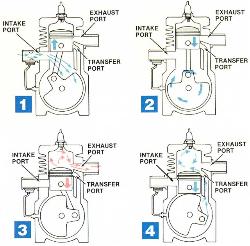The terms
"two-cycle" and "two-stroke" are often inter-changed when speaking
about two-cycle engines. These engines derive their name from the
amount of directional changes that the pistons make during each power
stroke. Internal combustion engines are used to produce mechanical
power from the chemical energy contained in fuels. The power-producing
part of the motor's operating cycle starts inside the motor's cylinders
with a compression process. Following this compression, the burning of
the fuel-air mixture then releases the fuel's chemical energy and
produces high-temperature, high-pressure combustion. These gases then
expand within the cylinder and transfer power to the piston. Thus, as
the engine is operated continuously, mechanical power is produced. Each
upward or downward movement of the piston is called a stroke.

Two-cycle engines
deliver one power stroke for each revolution of the crankshaft.
|
Where are two-cycle
engines used?
Two-cycle
engines
are inexpensive to build and operate when compared to four-cycle
engines. They are lighter in weight and have a higher power-to-weight
ratio than a 4 stroke engine. For these reasons, two-cycle engines are
very useful in applications such as lightweight scooters. Two-cycle
engines are also easier to start in cold temperatures. Part of this may
be due to their design and the lack of an oil sump. This is a reason
why these engines are also commonly used in snowmobiles and snow
blowers.
Because
two-cycle engines can effectively double the number of power strokes
per unit time when compared to four-cycle engines, power output is
increased. However, it does not increase by a factor of two. The
outputs of two-cycle engines range from only 20 to 60 percent above
those of equivalent-size four-cycle units. This lower than expected
increase is a result of the poorer than ideal charging efficiency, or
in other words, incomplete filling of the cylinder volume with fresh
fuel and air.
|
How are two-cycle engines different from
four-cycle engines?
|
|
| A four-cycle engine requires four
strokes
of the piston (two up and two down) and two revolutions of the
crankshaft to complete one combustion cycle and provide one power
stroke. |
The fundamental difference between two-cycle engines and four-cycle
engines is in their gas exchange process, or more simply, the removal
of the burned gases at the end of each expansion process and the
induction of a fresh mixture for the next cycle. The two-cycle engine
has an expansion, or power stroke, in each cylinder during each
revolution of the crankshaft. The exhaust and the charging processes
occur simultaneously as the piston moves through its lowest or bottom
center position.
In a four-cycle engine, the burned gases are first displaced by the
piston during an upward stroke, and then a fresh charge enters the
cylinder during the following downward stroke. This means that
four-cycle engines require two complete turns of the crankshaft to make
a power stroke, versus the single turn necessary in a two-cycle engine.
In other words, two-cycle engines operate on 360 degrees of crankshaft
rotation, whereas four-cycle engines operate on 720 degrees of
crankshaft rotation.
How
are two-cycle engines lubricated?
If you have ever used a two-stroke engine, you know that you have to
mix special
two-stroke oil in with the
gasoline. In a four-stroke engine, like your car uses the
crankcase is completely separate from the combustion chamber, so you
can fill the crankcase with heavy oil to lubricate the crankshaft
bearings, the bearings on either end of the piston's connecting rod and
the cylinder wall. In a two-stroke engine, on the other hand, the
crankcase is serving as a
pressurization chamber to
force air/fuel into the cylinder, so it can't hold a thick oil.
Instead, you mix oil in with the gas to lubricate the crankshaft,
connecting rod and cylinder walls. If you forget to mix in the oil, the
engine isn't going to last very long!
Two-cycle
motors are considered total-loss type lubricating systems. Because the
crankcase is part of the intake process, it cannot act as an oil sump
as is found on four-cycle engines. Lubricating traditional two-cycle
engines is done by mixing the oil with the fuel. Internal engine parts
are lubricated by this mixture of oil in the fuel during the intake
portion of the power stroke.
parts
of the above were excerpted
from AmsOil news article.